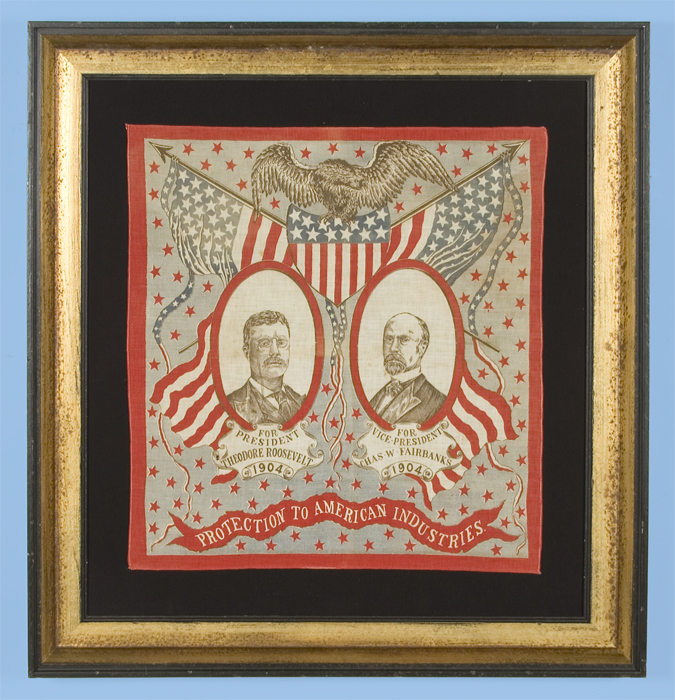
| |
JUGATE PORTRAIT KERCHIEF, MADE FOR THE 1904 PRESIDENTIAL CAMPAIGN OF THEODORE ROOSEVELT & CHARLES WARREN FAIRBANKS |
|
| Available: |
Sold |
| Frame Size (H x L): |
35.25" x 33" |
| Flag Size (H x L): |
23.75" x 22.25" |
|
| Description....: |
|
JUGATE PORTRAIT KERCHIEF, MADE FOR THE 1904 PRESIDENTIAL CAMPAIGN OF THEODORE ROOSEVELT & CHARLES WARREN FAIRBANKS:
Printed cotton kerchief, made for the 1904 presidential campaign of Theodore Roosevelt and Charles Warren Fairbanks. This jugate portrait variety (meaning that both candidates are pictured) is, without doubt, one of the most graphic and colorful designs among all known styles of political bandannas. Images of the two men appear in oval medallions, flanked by billowing flags, commissioning pennants, and a patriotic shield, on top of which is perched a large, spread-winged eagle. These appear over a background of falling stars. The text reads as follows: "For President, Theodore Roosevelt, 1904; For Vice President, Charles Warren Fairbanks, 1904". Under this is the campaign slogan: "Protection to American Industries", which had been used most prolifically on campaign textiles by Benjamin Harrison in 1888. The pro-American theme, however, aimed at limiting both trade and the number of new immigrant workers, carried itself through several elections. It is interesting to note that it is hardly a novel idea, having been continually revisited from the mid-19th century through the present.
An example of this kerchief is documented in "Threads of History: Americana Recorded on Cloth, 1775 to the Present", by Herbert Ridgeway Collins, Smithsonian Press, 1979 (item 863, pg. 346). This is the best text on American political textiles. Collins formerly served as Curator of Political History at the Smithsonian Institution. A similar, yet different kerchief, just as colorful and embellished, was made as a mate for the campaign of Alton Parker and Henry Davis. The Parker-Davis version is also documented (item 872, pg. 349).
Charles Fairbanks was, in some ways, as different from Roosevelt as one could possibly get. Reserved, soft-spoken, and a hard-line conservative, the Ohio-born Illinois senator was nicknamed the "Indiana Icicle". Born in a Log Cabin, Fairbanks would rise to become an attorney and eventually a railroad financier, serving as a chief counsel for mogul Jay Gould. He was elected as a Republican to the United States Senate in 1896.
Fairbanks was as good a balance as any, geographically, politically, and personally, to the progressive and outspoken, Rough-Rider from New York. Roosevelt appealed to members of both political parties, Fairbanks leveled out the ticket for hard-line, right-wing Republicans, and also solidified support in the growing and politically-important mid west. Only the firmly Democratic south voted firmly in opposition.
Democrat opponent, Alton B. Parker, was born in Cortland, New York. He was an attorney who practiced law in Kingston, New York before serving as a justice of the Supreme Court of New York from 1885 to 1889, then as Chief Judge of the New York Court of Appeals from 1898 to 1904. In 1900 he ran for vice president under William Jennings Bryan, who lost to the William McKinley and Roosevelt ticket.
Parker's running mate, Henry G. Davis, became a member of the West Virginia House of Delegates in 1865, just after its separation from Virginia (in 1864). He became a state senator in 1869 and in 1871 was elected to the United States Senate, serving two terms, with his service ending in 1883. At age 80, Davis was (and is) the oldest person to be nominated for President or Vice President on a major party ticket.
Parker was a conservative among his party members and his nomination of Davis would help carry the southern vote, but the two men were no match for the supreme popularity of Roosevelt.
Mounting: The kerchief was stitched to a background of 100% cotton, black in color, which has been washed to reduce excess dye. An acid-free agent was added to the wash to further set the dye and the fabric was heat-treated for the same purpose. The mount was then placed in a black-painted, hand-gilded and distressed Italian molding. Spacers keep the textile away from the glass, which is u.v. protective.
Condition: Minor fading of the blue ink. Very minor foxing. |
|
|
|
| Collector Level: |
Intermediate-Level Collectors and Special Gifts |
|
| Flag Type: |
|
|
| Star Count: |
|
|
| Earliest Date of Origin: |
1904 |
|
| Latest Date of Origin: |
1904 |
|
| State/Affiliation: |
New York |
|
| War Association: |
1898 Spanish American War |
|
| Price: |
SOLD |
|
| |
Views: 3485 |
|
|
|

